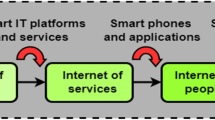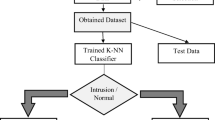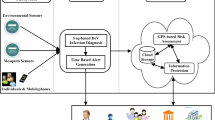Abstract
Mobile ad hoc network (MANET) is a collection of mobile, decentralized and self-organizing nodes that are used in special cases such as medical and military purposes. Securing mobile ad hoc network MANET is a crucial research issue. The properties of MANET impede the protection of the network’s environment against attacks. MANET as an open area of wireless mobile nodes allow external attackers to join the network easily and masquerade legitimate nodes. Therefore, the objective of this paper is to develop a distributed, self-organizing and hybrid intelligent model, called dendritic cell fuzzy algorithm (DCFA), for security routing in MANET. The DCFA model inspiring the detection functionality of dendritic cells (DCs) in human immune system (HIS) and the accurate decision-making functionality of fuzzy logic theory to detect network attacks in MANET. The DCFA model is developed and validated by detecting a flooding-based attack, namely, a resource consumption attack (RCA). QualNet v5.0.2 is used as a simulation environment to test the capability of DCFA in detecting RCA over MANET. The results show the capability of DCFA to perform the detection operation with high efficiency and effectiveness.

















Similar content being viewed by others
Notes
A fresh enough route contains a sequence number greater than or equal to that in the RREQ packet.
The unit of energy is joule. Mjoule is millijoule, which is equal to 1 × 10−3 joule.
References
Janeway CA, Travers P, Walport M, and Capra JD (2005) Immunobiology: the immune system in health and disease, 6 ed. vol. 1: Garland Science Publishing, New York
de Castro LN, Timmis J (2002) Artificial immune systems: a novel paradigm to pattern recognition. Artificial Neural networks in Pattern Recognition 1:67–84
Costa Silva G, Caminhas WM, Palhares RM (2017) Artificial immune systems applied to fault detection and isolation. Appl Soft Comput 57:118–131
Yang J, Liu X, Li T, Liang G, Liu S (2009) Distributed agents model for intrusion detection based on AIS. Knowl-Based Syst 22:115–119
Sarafijanovic S, Le Boudec JY (2005) An artificial immune system approach with secondary response for misbehavior detection in mobile ad hoc networks. IEEE Trans Neural Netw 16(5):1076–1087
Fanelli R (2010) Further experimentation with hybrid immune inspired network intrusion detection. Presented at the international conference on artificial immune systems
Zheng C, Sicker D (2013) A survey on biologically inspired algorithms for computer networking. IEEE Communications Surveys & Tutorials 15(3):1160–1191
Kant L, Young K, Younis O, Shallcross D, Sinkar K, McAuley A et al (2008) Network science based approaches to design and analyze MANETs for military applications. IEEE Commun Mag 46(11):55–61
Alsaqour R, Abdelhaq M, Saeed R, Uddin M, Alsukour O, Al-Hubaishi M et al (2015) Dynamic packet beaconing for GPSR mobile ad hoc position-based routing protocol using fuzzy logic. J Netw Comput Appl 47:32–46
Hu X, Chu TH, Leung VC, Ngai EC-H, Kruchten P, Chan HC (2015) A survey on mobile social networks: applications, platforms, system architectures, and future research directions. IEEE Communications Surveys & Tutorials 17:1557–1581
Yih-Chun H and Perrig A (2004) A survey of secure wireless ad hoc routing. Security & Privacy, IEEE, vol. 2, pp. 28–39
Lima M, Dos Santos A, Pujolle G (2009) A survey of survivability in mobile ad hoc networks. Communications Surveys & Tutorials, IEEE 11:66–77
Mokhtar B, Azab M (2015) Survey on security issues in vehicular ad hoc networks. Alexandria Engineering Journal 54:1115–1126
Perkins CE, Royer EM (1999) Ad-hoc on-demand distance vector routing. In: Proceedings of Second IEEE Workshop on Mobile Computing Systems and Applications, pp. 90–100
Abdelhaq M, Hassan R, Ismail M (2013) Performance evaluation of mobile ad hoc networks under flooding-based attacks. Int J Commun Syst. https://doi.org/10.1002/dac.2615
Pastrana S, Mitrokotsa A, Orfila A, Peris-Lopez P (2012) Evaluation of classification algorithms for intrusion detection in MANETs. Knowl-Based Syst 36:217–225
Mitchell R, Chen R (2014) A survey of intrusion detection in wireless network applications. Comput Commun 42:1–23
Le A, Loo J, Chai KK, Aiash M (2016) A specification-based IDS for detecting attacks on RPL-based network topology. Information 7:25
Nadeem A, Howarth MP (2013) A survey of MANET intrusion detection & prevention approaches for network layer attacks. IEEE Communications Surveys & Tutorials 15:2027–2045
Forrest S, Perelson AS, Allen L, Cherukuri R (1994) Self-nonself discrimination in a computer. In Research in Security and Privacy, 1994. Proceedings., 1994 IEEE Computer Society Symposium on, pp. 202–212
Matzinger P (2002) The danger model: a renewed sense of self. Science 296:301–305
Kumar S, Dutta K (2016) Intrusion detection in mobile ad hoc networks: techniques, systems, and future challenges. Security and Communication Networks
Ou C-M (2012) Host-based intrusion detection systems adapted from agent-based artificial immune systems. Neurocomputing 88:78–86
Chelly Z, Elouedi Z (2010) FDCM: A fuzzy dendritic cell method. International Conference on Artificial Immune Systems:102–115
Chelly Z, Elouedi Z (2016) A survey of the dendritic cell algorithm. Knowl Inf Syst 48:505–535
Fanelli RL (2010) Further experimentation with hybrid immune inspired network intrusion detection. International Conference on Artificial Immune Systems:264–275
Fanelli RL (2008) A hybrid model for immune inspired network intrusion detection. International Conference on Artificial Immune Systems:107–118
Wallenta C, Kim J, Bentley PJ, Hailes S (2010) Detecting interest cache poisoning in sensor networks using an artificial immune algorithm. Appl Intell 32:1–26
Drozda M, Schaust S, Szczerbicka H (2010) Immuno-inspired knowledge management for ad hoc wireless networks. Smart Information and Knowledge Management, ed: Springer, pp. 1–26
Drozda M, Schaust S, Schildt S, Szczerbicka H (2009) An Error Propagation Algorithm for Ad Hoc Wireless Networks. International Conference on Artificial Immune Systems:260–273
Greensmith J, Aickelin U, Tedesco G (2010) Information fusion for anomaly detection with the dendritic cell algorithm. Information Fusion 11:21–34
Greensmith J, Aickelin U, Cayzer S (2008) Detecting danger: The dendritic cell algorithm. Robust Intelligent Systems, ed: Springer, pp. 89–112
Gu F, Greensmith J, Aicklein U (2012) The dendritic cell algorithm for intrusion detection. in Biologically Inspired Networking and Sensing: Algorithms and Architectures, ed: IGI Global, pp. 84–102
Kim J, Bentley PJ, Aickelin U, Greensmith J, Tedesco G, Twycross J (2007) Immune system approaches to intrusion detection–a review. Nat Comput 6:413–466
Aickelin U, Bentley P, Cayzer S, Kim J, McLeod J (2003) Danger theory: The link between AIS and IDS? International Conference on Artificial Immune Systems:147–155
McClure S, Scambray J, Kurtz G (2005) Hacking exposed: network security secrets & solutions. McGraw-Hill/Osborne, New York
Sarafijanovic S, Le Boudec J-Y (2005) An artificial immune system for misbehavior detection in mobile ad-hoc networks with virtual thymus, clustering, danger signal and memory detectors. Int J Unconv Comput 1:221–254
Janeway CA (1998) The road less traveled: the role of innate immunity in the adaptive immune response-presidential address to the American Association of Immunologists. J Immunol 161:539–544
Wu SX, Banzhaf W (2010) The use of computational intelligence in intrusion detection systems: a review. Appl Soft Comput 10:1–35
Bretscher PA (1999) A two-step, two-signal model for the primary activation of precursor helper T cells. Proc Natl Acad Sci 96:185–190
e Sousa CR (2001) Dendritic cells as sensors of infection. Immunity 14:495–498
Oshashi PS, De Franco AL (2002) Making and breaking tolerance. Curr Opin Immunol 14:744–759
Motran CC, Ambrosio LF, Volpini X, Celias DP, Cervi L (2017) Dendritic cells and parasites: from recognition and activation to immune response instruction. Semin Immunopathol:199–213
Zadeh LA (2015) Fuzzy logic—a personal perspective. Fuzzy Sets Syst 281:4–20
Yan J, Ryan M, Power J (1995) Using fuzzy logic: towards intelligent systems. Prentice-Hall, Inc., Upper Saddle River
Cui S, Goldsmith AJ, Bahai A (2005) Energy-constrained modulation optimization. IEEE Transactions on Wireless Communications 4:2349–2360
Feeney LM, Nilsson M (2001) Investigating the energy consumption of a wireless network interface in an ad hoc networking environment. In: INFOCOM 2001. Twentieth Annual Joint Conference of the IEEE Computer and Communications Societies, pp. 1548–1557
Q. Simulator. (2012) Scalable network technologies. Available: http://www.scalable-networks.com/content/
Forkel I, Schinnenburg M, Wouters B (2003) Performance evaluation of soft handover in a realistic UMTS network. In The 57th IEEE Semiannual Vehicular Technology Conference, 2003. VTC 2003-Spring., pp. 1979-1983
Khalil I, Bagchi S, Shroff NB (2005) LITEWORP: a lightweight countermeasure for the wormhole attack in multihop wireless networks. in Dependable Systems and Networks, 2005. DSN 2005. Proceedings International Conference on, pp. 612–621
Ou C-M, Ou C, Wang Y-T (2013) Agent-Based Artificial Immune Systems (ABAIS) for intrusion detections: inspiration from danger theory. in Agent and Multi-Agent Systems in Distributed Systems-Digital Economy and E-Commerce, ed: Springer, pp. 67–94
Acknowledgments
This research project was funded by Deanship of Scientific Research, Princess Nourah bint Abdulrahman University, through the Program of Research Project Funding After Publication, grant No (41 - PRFA-P-2).
Author information
Authors and Affiliations
Corresponding author
Additional information
Publisher’s note
Springer Nature remains neutral with regard to jurisdictional claims in published maps and institutional affiliations.
Rights and permissions
About this article
Cite this article
Abdelhaq, M., Alsaqour, R., Algarni, A. et al. Human immune-based model for intrusion detection in mobile ad hoc networks. Peer-to-Peer Netw. Appl. 13, 1046–1068 (2020). https://doi.org/10.1007/s12083-019-00862-9
Received:
Accepted:
Published:
Issue Date:
DOI: https://doi.org/10.1007/s12083-019-00862-9




